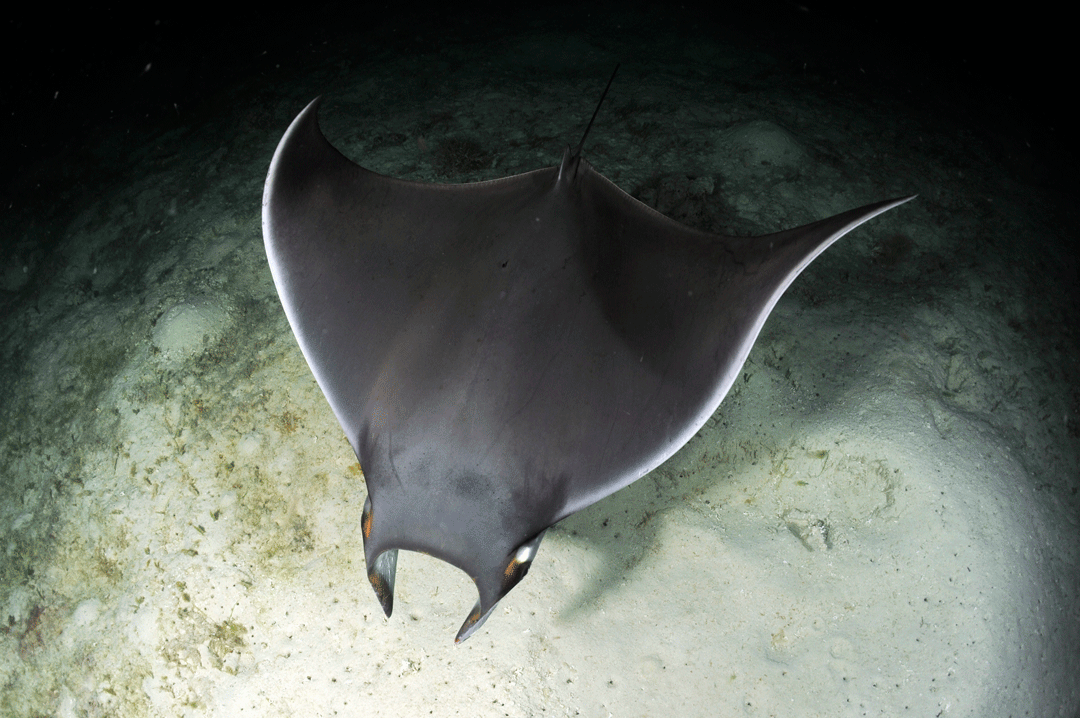The devil is in the detail
Known for its fascinating Inca culture, the Andes mountains and wide stretches of golden surf beaches, there is much to discover on land in the South American country Peru. Yet the ocean offshore Peru’s coastline holds many treasures, too. Its incredibly productive waters, due to the Humbold current drawing nutrient-rich upwellings up to the surface, attract a diversity of marine animals. Humpback whales visit between August and October, and are one of thirty-three cetaceans in the Peruvian Sea. Oceanic manta rays occur in northern Peru, seasonally migrating across the border into Ecuadorian waters. The ocean also teams with life of smaller fish such as anchovies; as a result Peru has one of the most extensive commercial anchovy, sardine and mackerel net fishery in the world.

An oceanic manta pictured in Peru. Photo © Mark Harding

Munk's devil ray. Photo © Guy Stevens | Manta Trust
If the above is not new to you, this surely is: Peru is one of the top five devil ray-fishing nations in the world. Devil rays (Mobula spp.) are targeted primarily for domestic consumption, with most fishing activity occurring in the north of Peru. The meat is dried and salted, and served as a specialty dish in coastal regions. Unlike the oceanic mantas, which received national protection in 2015 following extensive efforts by the Manta Trust team and collaborators, there is currently no management of the devil ray fishery in Peru. Data at landing sites is collected regularly by government officials and fisheries observers; however, the accuracy and quality of data is often poor primarily owing to a lack of training, and the challenge of correctly identifying the genus to species level.

Peruvian government representatives sharing their views on management challenges during the workshop. Photo © Stefy Rojas | Manta Trust
In collaboration with the Manta Trust Global Mobulid Conservation Programme, our local project aims to address this issue by building capacities among fisheries observers and government representatives to more accurately quantify and monitor the scale of the nation’s devil ray fisheries. Correctly identifying a species and collecting fisheries data is crucial for conservation and management planning. It allows governments and researchers to develop robust baseline data, for instance to create population estimates and quotas, upon which more informed management decisions can be made. Our project also aims to better understand the challenges that are preventing national management, through conducting workshops and interviews with observers, fishers and government representatives.

Peru project leader Stefy Rojas and Manta Trust affiliate Betty Laglbauer describing what characteristics to look for in the identification of mobulid rays. Photo © Stefy Rojas | Manta Trust

Representatives from the Peruvian government (IMARPE and PRODUCE) using the Manta Trust Guide to identify mobulid ray species. Photo © Stefy Rojas | Manta Trust
Earlier this year, we organized a capacity building workshop targeted at representatives from the Ministry of Environment and Fisheries Department in Tumbes, Peru. Over 30 participants were trained in the correct identification of species, collection of data and samples for morphological, reproductive and mobula growth studies. They learned about the anatomy of the different species of mobulas present in the fishery of Peru, how to distinguish the age and growth of mobulas using vertebral bands, and how to understand the reproductive biology of the mobulas and their importance in the fishery. An excerpt of the new Manta Trust Global Guide to Manta and Devil Rays of the World was translated into Spanish and distributed to participants as resource materials. The guide includes the most detailed overview to date on mobulid ray species characteristics, and best practice research protocols for collecting fisheries data on mobulids.

Participants of the capacity building workshop in Tumbes, Peru. Photo © Stefy Rojas | Manta Trust
This workshop also provided an opportunity for participants to share their views on current management challenges. A key issue that emerged was the bycatch of manta rays, which are frequently caught in the complex net fishery offshore Peru. Since manta rays are protected, landing them is an illegal activity yet enforcement is proving difficult. Fishermen face financial loss if they cut the nets to set the animals free, yet landing them comes with a risk. Mitigating bycatch, either through modification of gear or fishing methods or via temporal closures was identified as a potential solution. Interestingly, this is a challenge not only Peru is facing; mobulids are incidentally caught in at least 30 fisheries in 23 countries worldwide. Whilst it is crucial to continue the focus on implementing national policy and fisheries regulations, the “silent killer” known as bycatch keeps emerging as a future research and management priority.

An oceanic manta ray. Photo © Guy Stevens | Manta Trust
